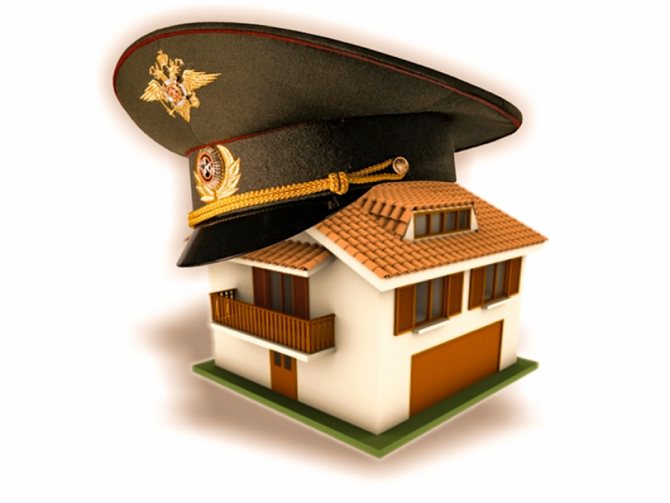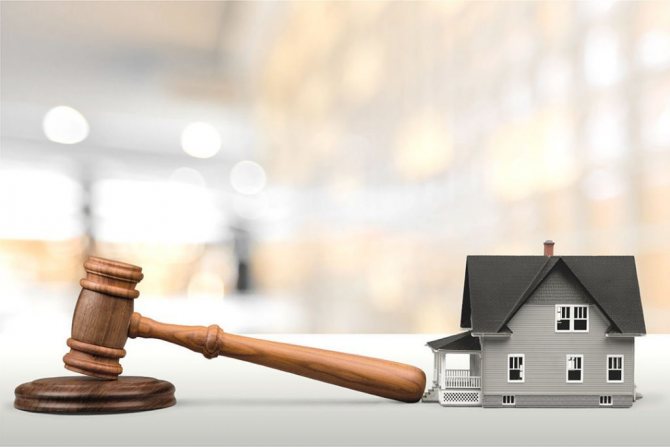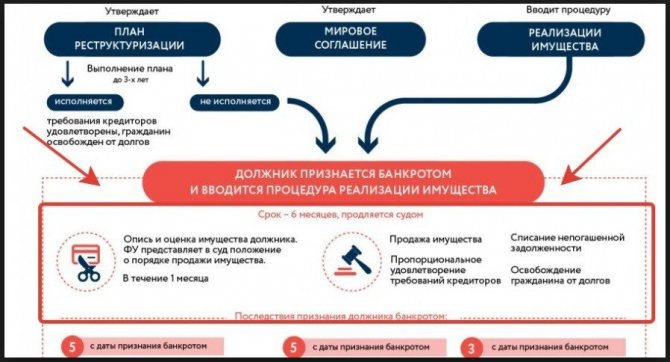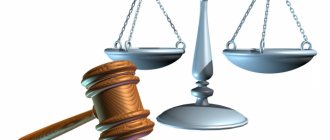What should a borrower do if he has nothing to pay?
Increasingly, borrowers prefer to take out job loss insurance along with the mortgage agreement, according to which the insurance company undertakes to pay the debt to the lender in the following cases:
- Liquidation of the organization.
- Reduction of staff.
- Conscription.
- The occurrence of circumstances beyond the control of either the employer or the employee.
If the borrower took out a mortgage and later quit voluntarily, the insurance company will not make payments, and the debt obligations will still remain with the debtor.
If insurance was not issued at all, and the borrower’s financial situation has noticeably worsened and he does not make monthly payments to repay the debt to the bank, the following happens:
- If the money is not received within three months of the due date, the financial institution takes legal action. To prevent this from happening, it is recommended to contact the creditor with an application for debt restructuring. If the decision is positive, the amount of the monthly payment will be reduced to an amount that allows the borrower to repay the debt without any problems.
- If the borrower answers calls from bank employees and explains their difficult financial situation, going to court may be delayed for six months from the date of the first delay.
- During legal proceedings, a decision may be made to arrest and confiscate the debtor's property. In this case, it is sold through auction. The proceeds go to pay off the debt to the bank. If there are funds left from the sale, the borrower can return them to himself, but provided that the debt is completely liquidated.
Important! The main goal of the bank is not to deprive the borrower of an apartment, but to return their own funds along with interest, so they go to court in exceptional cases and real estate is seized quite rarely.
What can a borrower do if he cannot pay his mortgage:
- Ask for debt restructuring. To do this, you should contact the bank with an application, agreement and income certificates showing that their amount has been significantly reduced.
- Take advantage of unemployment insurance if it was taken out when concluding the mortgage agreement.
- Go to court to initiate bankruptcy proceedings yourself. This will allow you to get rid of the obligation to pay penalties and fines, and if the outcome is favorable, the borrower will be obliged to either pay only the principal and interest, or the debt will be repaid through the sale of property. There is another option - reaching a settlement agreement with the creditor, when he offers the debtor new, more convenient terms for repaying the loan.
- Wait until the bank itself files a lawsuit. In this case, you will also be able to avoid paying fines and penalties, which often exceed the amount of the principal amount of the debt.
When applying for a mortgage, all borrowers should take into account that the purchased apartment will be pledged to the bank until the last payment is made, so during bankruptcy proceedings it can be sold through auction, even if the debtor has no other housing.
Scenario 1: the market price of the property exceeds the amount of debt
This option is the most favorable for the debtor. If he does not have the money to repay the loan, he can sell the property with the permission of the bank. Part of the funds will be used to completely repay the debt, and you can keep the rest for yourself.
You can sell your home without going to court, at your own request. Things to consider:
- If the sale is carried out at the will of the borrower, you need to sell the apartment as quickly as possible. Every day the amount of debt will increase due to the accrual of fines and penalties, and in the end it may turn out that even after the sale of the property, the debt will still remain unpaid.
- If minors are registered in the apartment, the sale is carried out only with the permission of the guardianship authorities, provided that they are provided with better living space. In such a situation, you can agree with relatives about registration in their housing, otherwise permission to sell the property will not be given.
Important! When it comes to the seizure of an apartment during bankruptcy proceedings, the presence or absence of children registered in it does not matter. If it is established that the debtor is a willful defaulter and has deliberately avoided fulfilling debt obligations, the property will be sold to pay off the debt to the financial institution.
To understand the situation when the cost of housing exceeds the amount of debt, it is enough to familiarize yourself with a clear example:
Lavrentiev O.N. applied to the bank for a mortgage loan, 10 days later his application was approved. The cost of the apartment is 2,900,000 rubles, the interest rate is 12% per annum, the down payment is 500,000 rubles. For the first year, he regularly repaid the loan, but then the organization for which he worked was liquidated, and there was no longer enough money for monthly payments. He did not have unemployment insurance.
The borrower explained the situation to the bank, and he was given a deferment on payments for three months. Subsequently, he realized that he would not be able to pay the mortgage and decided to sell the apartment, obtaining permission from a financial institution. At that time, the amount of debt together with interest was equal to 2,200,000 rubles, plus about 70,000 rubles. – fines and penalties.
Real estate Lavrentieva O.N. was sold for 3,000,000 rubles: while he was paying off the mortgage, the cost of housing in the region of his residence increased sharply. Of the total amount, the borrower gave the bank 2,270,000 rubles, and 730,000 rubles. I kept it for myself. From the proceeds from the sale, he repaid the “body” of the loan, interest and penalties.
Scenario 2: the amount of debt is higher than the cost of the apartment
This situation is the most common and most often occurs among borrowers who have chosen loan terms, according to which the amount of the monthly payment is reduced by increasing the term.
What can be done in this case:
- Ask the bank for debt restructuring. As a rule, financial institutions meet halfway, because it is important for them to return their own money and make a profit. There is also a downside: restructuring can be organized by increasing the loan term and reducing the amount of monthly payments, in which case the borrower overpays much more.
- Sell all existing property, incl. and a mortgaged apartment to get rid of debts and avoid litigation.
Scenario 3: the bank does not cooperate
This situation is the most problematic, and the borrower has only two options: wait until the bank itself goes to court to collect the debt, or file for bankruptcy on its own.
The bankruptcy procedure for a mortgage has several advantages, so it is better to choose it:
- From the moment the claim is accepted, the accrual of fines and penalties stops.
- You can stay with your home and get refinancing on more favorable terms.
- If a decision has been made to sell real estate, the bank can receive no more than 80% of its value. If there is an outstanding amount, payments will be significantly reduced.
What does a potential bankrupt need to know?
Before going to court, you should first consult with a lawyer and find out how you can get rid of debts, what is taken away during bankruptcy, and a number of other points that will help you get out of a difficult situation with minimal losses. Qualified support from a lawyer is simply necessary, since it will not be easy to confront the bank in court.
What difficulties might you encounter?
- The bank may file a lawsuit to declare the debtor insolvent if he has debt on loans that have nothing to do with the mortgage loan. This will lead to the fact that the apartment will be sold to pay off the resulting debt, even if all mortgage payments were made regularly and in full. But if the debtor independently applies to the court with a request to declare him insolvent, then the chances of preserving the mortgaged apartment, payments for which are made regularly without delays, will increase significantly.
- When bankruptcy proceedings are initiated by the debtor himself, bank employees often refuse to issue a certificate of the amount of debt or demand a certain payment for the provision of services. This violates the norms of current legislation. This document must be attached to the application for recognition of insolvency on certain grounds.
Before starting the bankruptcy procedure, it is recommended to contact the bank in order to try to negotiate a peaceful settlement of the problem that has arisen, which should be documented. How is this done? Contacting the bank is based on the fact that you have nothing to pay, and your mortgage debt is growing. In this regard, the debtor offers the bank to sell the apartment to pay off the existing debt, and return the difference to the borrower. Considering that such dispute resolution is not provided for at the legislative level, the bank will refuse. However, your attempt and written refusal during the trial will serve as evidence of your good faith.
Recommended article: How to buy a summer house with a mortgage
The termination of the pledge in case of bankruptcy is carried out upon the sale of the property at auction. In this case, the borrower receives 80% of the value of the property sold. From these funds the existing debt is repaid, and the remaining part is left to the bankrupt. 20% of the amount of housing sold goes to pay legal costs and services of a financial manager.
In practice, quite often the amount of debt turns out to be much higher than the market value of the property. This occurs because lenders set specific rates when they issue mortgages, as well as impose penalties and interest for late payments. If the debt still remains after the sale and repayment of creditor claims, then the entire amount is written off. There are no further obligations between the parties.
Will the apartment be taken away if it is the only one?
Is it possible to declare bankruptcy on a mortgage in the absence of other housing? People often mistakenly believe that if they have no other real estate, then they will not be able to take the apartment away from them and the bank will simply agree to write off the debt. Unfortunately, with collateral housing, not everything is so simple.
A financial institution will indeed not be able to select the premises on its own. But according to a court decision, this is quite realistic, since the norms of civil procedural legislation, if the property is collateral, defend the position of the creditor (Article 50 of the Law “On Mortgage”).
What will happen to the apartment in the event of bankruptcy and a mortgage with minor children living in the collateral property? Although the legislator guarantees that a minor child retains the right to housing, mortgaged housing does not fall under this provision. Therefore, even if there is a baby growing up in the family, or a pensioner or disabled person living in the family, this does not give citizens immunity from collection.
In case of bankruptcy, you can lose your mortgaged home
How to keep a mortgaged apartment during bankruptcy
Experts in bankruptcy cases and challenging real estate transactions advise citizens to do the following. If a person has an apartment with a mortgage, and its loss will lead to the lack of a place to live, then you can take out a consumer loan from other financial institutions. The bottom line is that if a citizen who is declared insolvent pays off the mortgage debt on time, and another lending bank declares the individual’s insolvency, then the apartment will not be taken away.
Why is that? The fact is that collateralized property will be sold only if foreclosure is applied to it (Article 446 of the Code of Civil Procedure of the Russian Federation). But the bank that issued the mortgage in this case will have no reason to contact the manager with an application to be included in the register of creditors.
Thus, the bankruptcy procedure if there is a mortgage in another bank may not turn out so badly for the debtor if he complies with the terms of the loan turnover. To save mortgaged property, you can use a consumer loan
What does bankruptcy of individuals provide for a mortgage?
Bankruptcy in the presence of a mortgage - as in any other case, provides a person with the opportunity to deal with accumulated debts and get out of the credit hole. There are three main options for the development of the situation, in other words, what can happen during the bankruptcy procedure:
- Debt restructuring – a special schedule for repayment is established.
- Sale of property - after it a decision is made to write off outstanding debts.
- Settlement agreement between debtor and creditor.
Debt restructuring is a gentle way to solve problems with creditors
Pros and cons of bankruptcy
Each scenario has both positive and negative sides. Very often, citizens do not even know about them and therefore they try to avoid the issue of launching the procedure. First of all, it is worth highlighting the advantages:
- If debt restructuring is introduced, a person gets the opportunity to more comfortably deal with his existing obligations. The timing and amount of payments are selected so that it is as convenient as possible for the debtor to pay them (otherwise the procedure becomes meaningless).
- Court decisions made are suspended for the duration of the procedure. Also, fines and penalties are not charged for existing debts.
- If the property is sold, everything that has not been repaid must be written off. This also applies to debts of creditors who did not have time to be included in the register.
- Seizures on property are lifted.
If we talk about the minuses, the consequences will be as follows:
- The procedure itself is quite long (at least 6 months) and expensive.
- Your credit history will be ruined. For a long time, a person will practically not be able to get a new loan.
- A temporary ban is issued on the acquisition of a share in the authorized capital of a legal entity.
- The status of an individual entrepreneur (if any) is cancelled.
- During the entire procedure, the citizen is prohibited from leaving the Russian Federation.
- For 3 years after the completion of bankruptcy, a person will not be allowed to hold leadership positions.
Important! After a decision has already been made and entered into force, re-filing an application to declare a citizen bankrupt is possible only after 5 years.
Procedure for military and foreign currency mortgages
Bankruptcy with a mortgage using foreign currency is essentially no different from ordinary bankruptcy. Although in fact, when people go through the process, it turns out that the amount of debt is much higher than they expected, and more than the apartment is actually worth. This happens even in cases where maternity capital was used for the down payment.
This happens due to the constant change and growth of the currency exchange rate. The only advantage in this situation is that after the sale, the citizen will not have to pay the difference between the amount of debt and how much he actually got after the sale.
As for military mortgages, bankruptcy proceedings simply cannot be carried out on them. The reason is that in this case the loan is paid not by an individual, but by the state. Accordingly, there simply cannot be debts. A delay can only occur if the military man has undertaken to make part of the payments himself.

Bankruptcy is not allowed for military mortgages
Attempts to avoid bankruptcy: alternative solutions
It is advisable to make a decision to file for bankruptcy after all measures for pre-trial settlement have been taken. Firstly, the official recognition of insolvency has a number of consequences for the debtor, secondly, this procedure is not cheap, and thirdly, when making a decision, the court takes into account the borrower’s efforts to get out of the debt trap.
Possible ways to pay off a mortgage without going through bankruptcy:
- Credit holidays. The best option for a borrower in case of temporary difficulties is to request the bank to grant a deferment on several payments. This possibility is sometimes specified in the loan agreement - during the “credit holiday” the client pays only interest, and the “body” of the loan is distributed among the remaining payments; as an option, the repayment period is increased. Disadvantages of the program: limited grace period, implementation not by all banks.
- Loan refinancing. Possibility of recalculating the mortgage at a lower interest rate. Many banks, in pursuit of clients, are ready to refinance the loan on more favorable terms. This option is easier to implement before delays appear, since most major representatives of the banking sector pay attention to credit reputation when refinancing a mortgage. The difference in percentage can reach 10%.
- Loan restructuring. Conducted by the bank that holds the collateral. The lender changes the debt repayment schedule based on the borrower's current income. As a rule, restructuring comes down to extending the repayment period. Under certain circumstances, the bank may write off accrued fines and penalties.
- Installment plan through AHML. Combat veterans, families with children, and other preferential categories of borrowers will be able to receive state support through AHML in difficult situations. The state can pay up to 1.5 million rubles for the debtor. (up to 20%) debt. The write-off is carried out as a one-time payment or to reduce monthly payments.
These measures will help preserve housing and get out of a series of delays. If there is no need to preserve the collateral, you can invite the bank to independently find a client for the purchase of real estate. The difference between the sale price and the amount of debt is returned to the debtor. With this option, the terms of sale are more favorable than in bankruptcy proceedings or forced collection of collateral.
How to prove insolvency?
Before filing a lawsuit, the debtor should contact the bank itself , where he took out the mortgage, and also write an application with a request to defer payments, carry out debt restructuring, etc.
Insolvency is determined based on the analysis:
- account statements;
- completion of transactions by the borrower over a period of 3 years;
- monthly income (personal and family members with whom the debtor lives);
- composition of property;
- additional types of income (if any).
After the official recognition of insolvency, an inventory of the debtor’s property is carried out in order to determine the subsequent sale. The proceeds will be used to pay off debt to the bank.

Even if the mortgage is eventually repaid, the bankrupt borrower will subsequently be subject to a number of restrictions. For example, he will not be able to take out a loan for 5 years. . Restrictions also apply to professional activities. For three years, the former borrower will not be able to hold senior management positions.
Features of bankruptcy with a mortgage
Specifics of declaring a bankrupt individual. persons with housing under a mortgage is as follows:
- If the debt is large, the apartment that is pledged will be sold at auction. Thus, the bank’s monetary requirements will be satisfied, and the borrower may be left without real estate.
- The mortgagee has certain advantages over other creditors - the proceeds cannot satisfy the claims of other lenders.
- An insolvent citizen may lose not only his home, but also other property. If there is nothing more to sell, the balance of the debt is written off, and the money problem simply becomes a headache for the bank, the developer, and sometimes the guarantor.
- If the property is sold for more than its value, the difference in price will be returned to the borrower. But such a situation is rather rare. The starting rate for selling an apartment is 80%, so often the money received from the sale goes to pay off penalties and fines. As practice shows, even the return of maternity capital is not always possible.
Thus, when starting the bankruptcy process due to the inability to repay the debt, you should be especially careful - the court has the right to oblige the citizen to say goodbye to his home.
Bankruptcy of individuals, apartment with mortgage - judicial practice
Situations often occur in life when an individual declares bankruptcy, and the apartment is under mortgage. In this case, the bank has the right to take away and sell the property to cover financial obligations. The judiciary supports creditors by seizing such property from debtors. Having registered children under 18 years of age does not prevent you from losing your home.
Let us highlight several typical situations in judicial practice:
- “Ivanova A.A. received a loan in the amount of two million rubles. Her real estate acted as collateral. During the year, she transferred funds on time. Due to the dismissal, difficulties arose with payments and delays appeared. The financial institution files for bankruptcy, and the debtor files for bankruptcy. By court decision, the property is sold."
An apartment that is pledged is filed in the event of bankruptcy of individuals. The funds remaining after the sale and settlement of the debt are transferred to the debtor.
- “A married couple took out a mortgage and got a two-room apartment at their disposal. Three years later, a situation occurred that made it impossible to pay off the loan. The lender filed for bankruptcy and demanded the sale of the home. As a result, it was sold, and the money went to offset the debt.
The key point is to include the secured creditor in the register.

How will the bankruptcy procedure proceed in 2019?
For individuals, the stages of the bankruptcy procedure for a mortgage look like this:
- Analysis of accumulated debts. All loans are taken into account here, even if they are taken from different banks.
- Collection of documents. Certificates about the balance of the debt will be required.
- Submitting a statement of claim to the Arbitration Court at the place of registration.
- At the first meeting, a financial manager is identified and a restructuring plan is drawn up.
- The mortgaged apartment is sold at auction under the hammer if it is determined that there is no other way to eliminate the debts.
A pleasant moment is that after the sale of an apartment taken on a mortgage, the borrower will no longer owe the bank anything if the money received was enough to cover the debt. If you continue to pay the loan regularly, the bank will not be able to take away your home, so the restructuring option is the most preferable for the borrower.
Bankruptcy mortgage procedure
Advice from lawyers:
1. Please tell me how long the bankruptcy procedure for a mortgage can last?
1.1. No less than six months usually.
Did the answer help you?YesNo
1.2. Maybe 1 year, maybe 2, maybe 3... It all depends on the specific circumstances and the conduct of the participants in the process. Arbitration manager Vitaly Snytko.
Did the answer help you?YesNo
1.3. Greetings, Marina. From 1 year. It depends on whether they want to buy your apartment at auction, how the financial manager will work, whether the secured creditor will make contact, and a dozen other circumstances.
Did the answer help you?YesNo
Consultation on your issue
8
Calls from landlines and mobiles are free throughout Russia
2. Is it possible to take out a mortgage after bankruptcy proceedings?
2.1. Natalya, you have the right to receive credit funds from banks. However, they often pay attention to your credit history and, especially if they see a history of bankruptcy, they refuse to issue funds. In any case, with a mortgage, you leave the property as collateral, so you require the banks to give a written refusal to your application, which you can appeal legally, and also, if there are illegal arguments, write complaints to higher and supervisory authorities (Central Bank, Prosecutor's Office)
Did the answer help you?YesNo
2.2. Hello! The bank may refuse based on your credit history.
Did the answer help you?YesNo
2.3. Hello, Natalia! In this case, everything depends on the bank. Now almost all banks in the questionnaire ask whether you have gone through the bankruptcy procedure. They may refuse. Sincerely, pom. arbitration manager Yu.V. Nikitina.
Did the answer help you?YesNo
3. If you go through the bankruptcy procedure, it will be possible to keep the apartment with a mortgage.
3.1. Hello. It is precisely the mortgaged apartment that cannot be saved in the event of bankruptcy of an individual. This is the only case.
Did the answer help you?YesNo
4. If the spouse is the title borrower of the mortgage, she fulfills all the terms of the agreement. My husband is going through bankruptcy proceedings, will the mortgaged apartment be put up for auction?
4.1. Hello! If, according to the mortgage agreement, you are co-borrowers, then foreclosure will be filed. If the agreement is executed only in your name, then the bank cannot claim this apartment in the event of bankruptcy of your spouse.
Did the answer help you?YesNo
5. If the apartment is shared with my husband (we are divorced), the mortgage is on the husband, I am a co-borrower, I want to go through bankruptcy proceedings, but the lawyers said that my half would go under the hammer, I didn’t want that. Is it possible to make a gift and draw up a purchase and sale agreement for a former spouse, and after what time can I file for bankruptcy? (3 years, 5 years, or no need to wait, you can immediately after the transaction)?
5.1. Is it possible to make a gift and draw up a purchase and sale agreement for your ex-spouse? It makes no sense. All transactions over a period of 3 years are disputed by the manager and the property is returned to you and included in the estate. If you want to do it, you need to wait 3 years and it’s better to have a purchase and sale agreement.
Did the answer help you?YesNo
5.2. In the event of bankruptcy, the mortgagee, the bank, will foreclose on the entire apartment.
Did the answer help you?YesNo
6. According to the writ of execution, seized land plots (which were under mortgage) are sold at auction from the LLC. Do I understand correctly that having purchased property at auction, the transaction can be challenged if the LLC begins bankruptcy proceedings? And for how long?
6.1. Good afternoon, Bulat! The answer to your question is not as clear-cut as it seems at first glance and requires a more detailed presentation to clarify all the circumstances. I am ready to assist you in resolving your issue (I can provide consultation in person, since I myself am in Kazan, I do not need to pay for an appointment).
Did the answer help you?YesNo
7. How long after full repayment of the mortgage is it safe to begin the bankruptcy procedure for individuals? faces?
7.1. What security can there be if, in the event of bankruptcy, the apartment can be sold first of all to pay off loan debts.
Did the answer help you?YesNo
7.2. Look at how they repaid it. Or it could be several years. Arbitration/financial manager Vitaly Snytko.
Did the answer help you?YesNo
8. I invested my maternity capital in a mortgaged apartment (already married) which my husband took out as a mortgage before marriage. During the bankruptcy procedure, can the apartment be taken into bankruptcy?
8.1. Good afternoon If there is only one housing, within the framework of the law, the only housing is inviolable for debt collection.
Did the answer help you?YesNo
8.2. Hello! Unfortunately, if your spouse decides to file bankruptcy for an individual, the bank will immediately file a claim with the court to foreclose on the pledged property. The “inviolability of the sole residence” provision does not apply to mortgages. In accordance with Art. 446 of the Civil Code of the Russian Federation, residential premises (parts thereof), if for the debtor citizen and members of his family living together in the premises owned, it is the only premises suitable for permanent residence, with the exception of
the property
specified in this paragraph ,
if it is the subject of a mortgage
and can be foreclosed on in accordance with the legislation on mortgages.
Did the answer help you?YesNo
8.3. During whose bankruptcy proceedings? Consult in person, taking into account all the circumstances. Arbitration/financial manager Vitaly Snytko.
Did the answer help you?YesNo
9. Anyone in the know please! I went through the bankruptcy procedure as an individual. face in 2020 Will they give me a mortgage? If yes, then after what time (there is information that after 5 years). And if anyone has come across which bank approves.
9.1. In theory, any bank can give you a loan. But they are unlikely to do this because they will have information about your bankruptcy status.
Did the answer help you?YesNo
10. I have debts to Zapsibkombank of 1.5 million rubles. I don't work anywhere. Debt for more than 5 years. Former entrepreneur. I want to file for bankruptcy. But I have a mortgage on non-residential premises from Sberbank. I won't be able to file for bankruptcy? Will the store be put up for auction? But it belongs to Sberbank.
10.1. Hello. The store belongs to YOU, it is simply pledged. You can't go bankrupt. You need to look at the loan agreement and payment schedule; perhaps the statute of limitations has expired for the entire amount or part of it.
Did the answer help you?YesNo
10.2. No mortgage is just the right of the mortgagee to foreclose on the property. The owner is you. If Sberbank submits its demands to the register in time, the premises will be sold at auction. The mortgage is terminated only by making an entry in Rosreestr.
Did the answer help you?YesNo
10.3. Hello, there are several options, you need a personal consultation. The bankruptcy procedure itself is quite expensive (from 80 tr in simple cases) and long (within a year). Consult personally with a specialist in the field.
Did the answer help you?YesNo
11. Is it possible to file a bankruptcy procedure with an apartment under a mortgage, so that the mortgage is not affected, since this apartment is the only residence.
11.1. Yes, it is possible to carry out a bankruptcy procedure and the apartment will not be included in the bankruptcy estate.
Did the answer help you?YesNo
11.2. Hello, Semyon! The only housing may be foreclosed on in accordance with mortgage legislation; (Article 446 of the Code of Civil Procedure of the Russian Federation, Article 50 of the Law “On Mortgage”).
Did the answer help you?YesNo
11.3. This will only happen if the secured creditor under the obligation secured by the mortgage of the apartment is not included or is included with the loss of security rights in the register of creditors' claims.
Did the answer help you?YesNo
11.4. It is possible that if the secured creditor is included in the RTK in time, the apartment will be included in the bankruptcy estate and sold at auction, even if it is the only housing.
Did the answer help you?YesNo
12. Bailiffs imposed a mortgage ban on the apartment. Moreover, the apartment has 2 owners. The arrest was imposed because 1 of the owners has a debt to the individual. face and began bankruptcy proceedings. Will they be able to sell this apartment for his debts if the second owner is ready to pay for the mortgage on his own? There are no debts to the bank.
12.1. Hello, as part of the bankruptcy procedure, the property that is the subject of a mortgage will be sold. All the best!
Did the answer help you?YesNo
13. I went through bankruptcy proceedings. The only housing in the apartment is 1/3 share. The housing encumbrance was lifted in July 19, can I sell the apartment to clients with a mortgage? Why did the bank refuse me?
13.1. Because you are bankrupt.
Did the answer help you?YesNo
13.2. The layman's answer is incorrect. Visitors to this site do not know why the bank refused you. Arbitration/financial manager Vitaly Snytko.
Did the answer help you?YesNo
Consultation on your issue
8
Calls from landlines and mobiles are free throughout Russia
14. I bought an apartment through the assignment of rights to the management, the agreement was registered in the Russian register. The apartment was purchased with a Sberbank mortgage. The developer has started bankruptcy proceedings and a manager has been appointed. In the extract from the court, the apartment is listed as collateral with the bank, which filed for bankruptcy. What will this mean for me? There is another nuance: the collateral includes a creative workshop, and I have a residential apartment, but we are talking about the same premises.
14.1. The first step is to submit an application to the arbitration court, where the bankruptcy case will be heard in order to request that you be included in the register of creditors' claims. Such a register is opened when bankruptcy proceedings are initiated against the developer. You are given 90 days to submit your application. The court also opens a register for the transfer of an apartment, which can be obtained after its completion. In addition, find out what actions the bank with which you have a mortgage agreement is going to take.
Did the answer help you?YesNo
15. I am a mortgagor under a mortgage agreement. The subject of the contract is my only home. I am currently in bankruptcy proceedings. persons - sale of property. Will the agreement lose legal force? The bank will not be able to foreclose on my apartment? The debtor is required to pay the remaining balance of the mortgage in full.
15.1. Good afternoon Just the mortgage agreement has legal force, the lender can only foreclose on the only housing within the framework of this agreement. In a specific case, you should think again about bankruptcy if there is a mortgage on your only home.
Did the answer help you?YesNo
16. I am a guarantor for a friend for loan restructuring. She signed it up for 10 years, paid for 7 years and decided to file for bankruptcy. I'm going to take out a mortgage next year. Will her actions affect my credit history?
16.1. You are jointly responsible for the loan. If the main debtor fails to repay the loan, the bank may make a claim against you. As for the bankruptcy procedure, only after its completion will it be possible to understand whether your friend’s obligation to pay the debt to the bank will end or not; there we can also talk about the termination of the agency agreement.
Did the answer help you?YesNo
17. I have a mortgage, which I pay regularly. And there are debts in three banks, in addition to where the mortgage is. Lawyers propose bankruptcy proceedings and promise that they will save the apartment. Is it so?
17.1. Irina, I believe that your lawyers are, to put it mildly, disingenuous; you cannot declare a person bankrupt, that is, unable to fulfill some obligations and leave other obligations aside.
Did the answer help you?YesNo
17.2. — Hello dear site visitor, no, not like that. Good luck to you and all the best, with respect, lawyer Legostaeva A.V.
Did the answer help you?YesNo
18. My ex-husband filed for bankruptcy; he was the borrower when we took out a mortgage from Sberbank, and I was a co-borrower. Do I need to write a waiver of my 1/2 plot, the house burned down in a fire.
18.1. What does it mean to “renounce” your property? There is no such concept in the law. Please clarify the question. Arbitration/financial manager Vitaly Snytko.
Did the answer help you?YesNo
19. I purchased a land plot from an individual, the plot was encumbered, and I received the bank’s consent to the transaction. Now I am the owner, but the mortgage weighs on me. The bank is bankrupt. To which court should an application be filed to remove the encumbrance from the land plot, to the court at the location of the land plot or to the court where the bankruptcy procedure is taking place, if where the bankruptcy procedure needs to be opened as a new case or as a claim of a creditor in an ongoing bankruptcy case? Thank you!
19.1. Firstly, it is not a fact that you can demand the removal of this burden. Maybe it has been preserved. We need to study the documents. Such a claim is filed at the location of the property in a court of general jurisdiction in your case. Arbitration/financial manager Vitaly Snytko.
Did the answer help you?YesNo
19.2. The encumbrances will not be removed even in court! The bankrupt has a legal successor... as a rule, the DIA. Don't even try!
Did the answer help you?YesNo
20. I am a disabled person of the first group, I have a debt for an unpaid mortgage in the amount of 1.3 million, there is no apartment, since it was sold at auction. I want to carry out bankruptcy proceedings, for this I need an extract from my personal pension account. I am a pensioner of the Ministry of Internal Affairs, do I need to take any certificates from the pension Ministry of Internal Affairs, or do I only need a personal account statement from the civil pension?
20.1. Good afternoon Vyacheslav, are you preparing your application to the court yourself? I recommend that you contact specialists - they know where and what documents you need to obtain to attach to your application. In addition, preparing and submitting an application is only a tiny part of the entire required amount of work. Will you also go to court hearings at the Arbitration Court on your own? Regarding your question specifically: a certificate from the Pension Fund of the Russian Federation is needed to show the court the source of your income and its amount. If your pension is paid not by the Pension Fund of the Russian Federation, but by some departmental fund, then naturally a certificate from there is also needed. If you need help in a bankruptcy case, you can contact 89281941479.
Did the answer help you?YesNo
Why, after the completion of the bankruptcy procedure of the Federal Law, was the mortgage debt not completely written off? The apartment was sold.
I'm at the bankruptcy procedure station, I'm married and we have a marriage contract that states,
I am filing for bankruptcy. There is a room with a mortgage, bought with capital. The room is being sold. Is it possible to return the mat? Capital..
Bankruptcy proceedings are underway. The house was purchased with a mortgage. The loan was paid in full before bankruptcy began.
Is it possible to make changes to a mortgage that already exists (change of mortgagee)?
The question is this. In 2017 there was bankruptcy as an individual. faces. Now I have an apartment that I want to sell.
I found out that in addition to our joint mortgage, my husband also has a loaded credit card for a large amount,
The creditor initiated bankruptcy proceedings. How will this affect me? I own half an apartment with a mortgage. There is nothing more.
I ask for advice on the following issue: my wife, while married, wants to file an application to declare herself bankrupt.
I would like to resolve the issue. There is a mortgage. The spouse goes as a borrower, but he personally has more than 600 debts,
He filed for bankruptcy, in 1992 my mother received an apartment, it was privatized for the two of us in an equal share of 1/2,
What to do if your ex-spouse is declared bankrupt
In practice, various situations occur. One of them is the bankruptcy of a spouse due to a mortgage, when the ex-husband does not repay the loan, and the wife has paid off her part of the debt. The main question: what to do with the money the woman has already paid?
To answer, you should refer to the conclusions made in 2011 by the Supreme Arbitration Court (now the Supreme Court of the Russian Federation). Resolution No. 51 states that property acquired during marriage is jointly acquired and therefore is not included in the bankruptcy estate.
However, in order to protect the rights of the creditor, the manager may require the allocation of part of the apartment. In this case, foreclosure will be applied to half of the real estate that belongs to the husband. If a claim for division of common property is filed during the procedure for the sale of property, the proceeds are divided between the spouses. The wife takes the funds she invested, and the bank takes the share due to the husband.
By analogy, cases are resolved when two or more co-borrowers took out a mortgage. Citizens who have repaid their debts are allocated their share or receive a refund for the property sold.
Step-by-step procedure for rehabilitation of an individual with a mortgage
Understanding the bankruptcy scheme, the cost and nuances of the legal process, it will be easier to decide whether such a step is necessary. You can go the whole way on your own, but it is better to enlist the support of an experienced lawyer in this matter.
Risk assessment and decision making
It is necessary to understand that if the debtor is denied restructuring, he risks being left without acquired property. The money from its sale is used to pay off current obligations and accrued fines.
What is the risk of a person declared bankrupt:
- movable property: cars, yachts, furniture, household appliances and luxury goods, if their price is over 50 thousand rubles;
- real estate;
- collateral property.
Important! Almost all property registered in the name of the debtor, as well as in the name of the spouse if it was acquired during marriage, is at risk
Some try to be cunning and, before filing for bankruptcy, transfer all their property, which they can write off to relatives. That's not to say it doesn't work, but you have to think it through carefully. There is a very high probability (there is a lot of judicial practice) that all transactions made over the previous three years can be canceled by the court.
According to the Code of Civil Procedure of the Russian Federation, in case of bankruptcy, individuals do not have the right to recover:
- personal belongings, household items;
- furniture worth up to 50 thousand rubles;
- vehicles for disabled people;
- single housing, land plots, with the exception of owned real estate;
- property used by the debtor for work or income generation.
If there is no valuable property in the property, or it is not a pity to lose it, then it is necessary to calculate the feasibility of rehabilitation.
Organizational aspects: cost and timing of the bankruptcy procedure
Based on judicial practice, the average price of one reorganization will cost an individual 40-45 thousand rubles. The price includes the remuneration of the financial manager (minimum - 25 thousand rubles), publications in the media, state duty, extracts from state registers and postage. If a lawyer is involved in the process, the cost of bankruptcy will increase.
On average, court proceedings are delayed by a year. It can take up to 3 months to collect documents, setting up a trial takes about a month, and selling property takes about 8 months. If a restructuring is agreed upon, three years are given to repay the debt.
On a note. The procedure may take a long time, and the likelihood of this is high if the debtor has made transactions to alienate property over the past three years. Concluded agreements of gift, purchase and sale, division of property between spouses can be challenged by the financial manager or creditor. To avoid this, you should wait a longer period so that transactions are not taken into account due to the statute of limitations. Or another option is to make deals with non-close relatives or friends in whom you are confident.
Preparation of documents and submission of application
The Law on Bankruptcy of Individuals requires the submission of a number of documents:
- Identification. This category includes: passport, marriage certificates, marriage contract, documents for children, dependents in the care of the debtor.
- State registration of an individual. A TIN, a certificate of SNIPS, documents on registration/absence of an individual entrepreneur are provided.
- Documents about the financial condition of the debtor. Certificate of income, bank statements on deposit and current accounts for three years, on money transfers, copies of the work book. If necessary, confirm your unemployed status. Documents for existing property, including collateral.
- Loan documentation. Agreements for all current loans, bank statements confirming the amount of debt, the amount of accrued/paid fines.
- Explanation of the reasons for the deterioration in solvency. This group includes: medical certificates, disability documents, statements of salary reduction or dismissal.
A complete package of documents with the application is submitted to the local Arbitration Court. Papers can be sent by mail, and the application can be filled out online on the Arbitration website. As an option, use a representative by drawing up a notarized power of attorney for him.
In the bankruptcy application, the applicant indicates:
- Document header: name of the court, applicant’s details, list of creditors.
- Main part: description of the current situation, indicating the total debt to all lenders, the period of arrears, the reasons for the sharp deterioration in solvency. In this part, it is necessary to inform the court about attempts to resolve the problem debt, backing up the words with a written refusal of the bank to restructure. It is necessary to list all property owned, indicate the amount of income and balances in bank accounts.
- Resolution part. A specific request is made to declare the citizen bankrupt.
- List of attached documents.
Proceedings in court
A copy of the statement of claim is sent to all creditors. The debtor deposits into the court's deposit account the amount to pay for the work of the manager at the first stage and transfers the state fee. All receipts must be kept.
During the trial, all the applicant’s property is seized, and the debtor and his opponent-creditors receive a corresponding notification. Accounts, including salary accounts, are also under arrest.
Advice. You can receive no more than 10 thousand rubles for maintenance upon a separate request, so it is better to take care in advance of transferring payments to the “cash field”
When a citizen is declared bankrupt, one of three measures is possible:
- settlement agreement;
- loan restructuring;
- sale of property.
After declaring the insolvency of an individual, you can submit a request to the bailiffs to terminate enforcement proceedings, if they were previously initiated by creditors. Further developments depend on the decision made by the Arbitration.
General features of bankruptcy
Before we consider the features of bankruptcy in a situation of inability to repay a mortgage debt, it is necessary to say a few words about the bankruptcy procedure itself.
Let us highlight its main features in relation to declaring an individual bankrupt:
- The debtor himself can go to court directly, but provided that the amount of the claims is at least half a million rubles, and the delay in execution is 3 months from the date of the obligation to fulfill them.
- The application is submitted to the arbitration court. In this case, the following documents must be attached to the application:
- confirming the debt, the grounds for its occurrence and the inability to repay all debt existing at the time of application;
- about transactions worth more than 300 thousand rubles completed during the three years preceding the submission of the application, as well as transactions with real estate, transport, securities and shares in the authorized capital, if such transactions took place;
- about a citizen’s income for the same 3-year period and tax withholdings;
- about banking operations, deposits, accounts, etc. for the same 3-year period;
- a detailed list of all creditors and debtors of the applicant, where their data and each individual monetary obligation should be listed;
- a list of property, including collateral, that the debtor has, indicating its location, as well as title documents for each property;
- a number of other documents specified by the Bankruptcy Law.
- The application must contain a proposal to appoint a financial manager or consent to his appointment by the court.
- You will need to deposit a certain amount of the manager’s remuneration into the court’s deposit or submit a request for a deferment until the date of consideration of the application.
Filing for bankruptcy is not a way to cancel all debts and relieve yourself of financial burden . First of all, the arbitration tribunal will consider the possibility of repaying the applicant’s debts on mutually beneficial terms for all participants in the process. That is why the effectiveness of debt restructuring or the conclusion of a settlement agreement by the debtor and creditors will be primarily studied. The sale of the debtor's property is an extreme measure, which is resorted to when other options are impossible or have exhausted themselves .
Declaration of bankruptcy with cancellation of outstanding debts is the very last thing that will be considered by the court, so you should not count on a quick and simple solution. The process is likely to be lengthy and, quite possibly, financially costly, involving legal costs, payment of remuneration to the manager and other expenses associated with the use of certain procedures by the court.
Our lawyers know the answer to your question
If you want to find out
how to solve your particular problem
, then
ask
our duty lawyer online.
It's fast, convenient and free
!
or by phone:
- Moscow and region: +7-499-938-54-25
- St. Petersburg and region: +7-812-467-37-54
- Federal: +7-800-350-84-02
Mortgage in case of bankruptcy of an individual: what will happen to the mortgaged apartment?

For many residents of the Russian Federation, an apartment on credit is the only way to become the owner of their own square meters. By registering living space under such conditions, most borrowers are confident in their financial solvency and have no doubt that they will repay the loan on time. However, paying off mortgage debt is a long-term “marathon”, along the way of which unforeseen obstacles may arise. Unexpected dismissal from work, pregnancy, illness - just a small list of possible circumstances that lead to destabilization of the financial situation. What can you do to avoid increasing your debt? There is a way out - an individual can declare himself bankrupt. Let’s take a closer look at what the features of a mortgage are in the event of bankruptcy of an individual, and what the consequences of the procedure may be.
Stages of bankruptcy with a mortgage
In order to initiate the process of declaring an individual bankrupt, he must meet two requirements. Firstly, the amount of debt must be at least 500,000 rubles. Secondly, the loan must be overdue for at least 3 months. If the mortgage borrower meets these two characteristics, then he can apply to the Arbitration Court to declare himself bankrupt. It is worth noting that such cases are resolved through the court; the bank will not be able to write off the debt without an appropriate court order.
The mortgage bankruptcy procedure can have two scenarios:
- Mortgage restructuring. In this case, the bank can offer the borrower more favorable interest rates and recalculate the amount of the final debt that he will have to pay within three years. Thus, the borrower receives some respite to stabilize his financial situation and, as a result, the opportunity to retain the apartment. However, only a small percentage of personal insolvency cases follow this course of events. This is due to a number of features that an individual must comply with. For example, the monthly income of an individual must be at least 30,000 rubles.
- Sale of property. As practice shows, 85% of cases fall into this category. The consequence of the sale of mortgaged property is the loss of housing in the process of recognizing insolvency, since it is the bank that is the owner of the mortgaged property.
The procedure for declaring an individual bankrupt includes checking the validity of insolvency. Thus, the debtor needs to confirm his financial insolvency. After this, the borrower provides an inventory of his property, which will be included in the bankruptcy estate for its further sale after the trial.
Features of bankruptcy under a mortgage of an individual
A feature of the insolvency process is to provide assistance to the debtor so that he can get out of the debt hole. At the same time, the legislation clearly states which property is not subject to sale. The following are subject to exclusion from the bankruptcy estate:
- The only housing suitable for an individual and his family. Please note that the apartment or house must be owned by the debtor. Thus, it will not be possible to avoid the loss of mortgage housing as a consequence of bankruptcy.
- Personal transport and specialized equipment that is used in the process of performing professional activities. It is important that the total cost of equipment or a car does not exceed one hundred subsistence minimums.
- According to Art. 446 of the Code of Civil Procedure of the Russian Federation, essential items, furniture, and household appliances are not confiscated from the debtor.
However, all methods of income of an individual are included in the bankruptcy estate. But the bankrupt will not be left without money, since an individual with this status will be paid the means to subsist (in the amount of the minimum wage), as well as the minimum wage for the payment of alimony. Moreover, the debtor retains social benefits and an insurance pension.
Consequences of bankruptcy with a mortgage
As already noted, it is almost impossible to avoid the sale of mortgaged housing during bankruptcy proceedings. In most cases, people lose mortgaged apartments if they do not seek qualified help from lawyers who can develop individual ways to solve financial difficulties without losing their home. YurlexProf employees know the right ways to preserve mortgaged housing during bankruptcy filing.
If an individual does not turn to professionals in time, and, as a result, the apartment goes to the bank, then you should familiarize yourself with how the proceeds will be distributed after its sale. According to the law, the proceeds from the sale of real estate will be used to repay the mortgage loan, pay the court deposit, and also pay for the services of a financial manager. In percentage terms, it will look like this: 80% goes to the mortgage lender, 7% is transferred to the financial manager, the rest of the money goes to pay off debts of the 1st and 2nd stages. You can keep the remaining funds for yourself. The loss of a mortgaged home is not the only consequence of declaring an individual bankrupt. In particular, recognition of insolvency has the following features:
- an individual who has officially gone through the bankruptcy procedure cannot apply for re-writing off debts over the next five years;
- at the end of the insolvency process, the bankrupt is obliged to periodically document his status as the financial institution from which the mortgage was taken out;
- An individual cannot become a founder or co-founder of an organization within three years.
Thus, the main consequence of the bankruptcy procedure with a mortgage is the loss of the mortgaged apartment, so it is worth understanding what stages the process of selling mortgaged housing includes:
- First of all, the collateral apartment is included in the total bankruptcy estate of property that will be sent for auction.
- Next, the cost of square meters is assessed. It should be carried out by an independent specialist to avoid consequences such as recognition of the assessment as biased.
- The real estate appraisal report is sent to two parties in the bankruptcy process—the debtor and the creditor. If both parties agree on the cost of housing, then the report is submitted to the court. If there are no objections, the price set by the appraiser becomes the starting price of the property at auction.
- At this stage of the housing sales process, an auction is held. The banking organization independently selects the organizer of electronic trading.
- After the sale of an apartment or house, all proceeds are credited to a special account, which only the financial manager of the individual has the right to manage. The responsibilities of the financial manager include the distribution of finances in accordance with the letter of the law.
There are cases when housing taken out with a mortgage does not go to auction. In such cases, the bank may keep it.
Is it possible to get a mortgage after bankruptcy?
As noted above, the main consequence of the bankruptcy process with a mortgage is the loss of housing, so many debtors are concerned about whether it will be possible to take out a mortgage again, and what features of the procedure for obtaining a new loan can await them.
According to Federal Law No. 127-FZ “On Insolvency (Bankruptcy)”, there is no restriction on taking out a second mortgage immediately after an individual is declared insolvent. Theoretically, the bankrupt can apply to a financial institution for a loan the next day after completing the procedure. In fact, not everything is as simple as it seems at first glance. The catch lies in the peculiarities of issuing a mortgage. First of all, when issuing a loan, the bank will pay attention to the borrower’s credit history. And since the individual already has bankrupt status, this will not work in his favor. But nothing is impossible, and practice shows that it is possible to find a way out of even such a situation.
To do this, the borrower needs to improve his credit history and prove that his financial situation has significantly improved. A potential creditor will not take the former debtor’s word for it; only official data will be of significant importance to him. The lender can be convinced:
- purchased movable or immovable property after the end of the bankruptcy procedure;
- availability of a deposit in the name of an individual, which is steadily replenished;
- presence of an official place of work.
Already repaid loans can also have a beneficial effect on your credit history. For example, after 10-12 months after the insolvency process, you can try to take out several small loans (up to 10,000 rubles) and make timely payments on them. The fact that a bankrupt pays the loan on time can convince the lender of his solvency, so time is considered the main feature of obtaining a new mortgage. You must first create a positive credit history, and then apply for a mortgage.
How to avoid losing collateral housing
The bankruptcy procedure necessarily includes the foreclosure of an apartment or house registered as a mortgage. Obviously, for an individual whose property does not have any housing other than collateral, such a consequence of the insolvency process is undesirable, so he is interested in alternative ways to resolve debt obligations and preserve housing.
Please note that in the bankruptcy procedure it does not matter whether a mortgage was taken out when maternity capital was used. Also, the judge will not pay attention to such features as the period of residence in the apartment or the presence of minor children registered in the apartment. For this reason, an individual can do the following before starting mortgage bankruptcy proceedings:
- Apply for a mortgage holiday. According to their features, lenders do not impose any consequences of late loan payments on an individual for six months, including fines or penalties. To apply for a vacation, the mortgaged housing must be the only one owned by the debtor, the mortgage amount must not exceed 15,000,000 rubles, and arrears are not allowed. Debtors who unexpectedly found themselves unemployed for a good reason, as well as persons who had a child or new dependents, for example, disabled parents, can apply for the mortgage holiday procedure.
- Apply for refinancing. The peculiarity of the refinancing process is to take out a consumer loan equal to the amount of the remaining mortgage debt. Thus, the loan will be used to pay off the mortgage debt, and subsequently the housing will become the property of the borrower. After this, the individual can begin bankruptcy proceedings. It is worth paying attention to the fact that this method has its own characteristics. Firstly, if the debtor owns another home, it will not be possible to avoid the consequences of including one of the living spaces in the bankruptcy estate. Secondly, so that the financial manager does not regard refinancing as fraudulent, it is worth making monthly loan payments for at least six months.
These two methods can give individuals additional time to resolve their financial difficulties and avoid the consequences of foreclosure on their only living space.
Conclusion
The bankruptcy procedure is sometimes the only way out of a difficult financial situation. However, if the list of an individual’s property includes housing purchased with a mortgage, it will be seized, therefore, before starting the process of declaring financial insolvency, you should carefully familiarize yourself with its features and possible consequences.
Remember that it is better to initiate bankruptcy yourself, without waiting for active actions by the creditor. Delaying it may lead to additional fines, an increase in the monthly interest or the total amount of debt. To successfully complete the entire procedure with minimal losses, it is better to take legal help.
Benefits of the debtor upon recognition of his insolvency
Declaring a debtor bankrupt does not cancel his obligations to the bank and does not automatically relieve him of the financial burden. The procedure should be considered as an opportunity to return the balance of the debt on more favorable terms.
Important! The arbitration court initially analyzes the possibility of restructuring the loan or signing a settlement agreement between the parties. Selling property is an extreme step if all attempts to recover funds have been exhausted
The procedure for handling collateral in bankruptcy is not much different from the actions when a creditor collects a debt in court. However, there are a number of significant advantages for the debtor if his main goal is to maintain ownership of the home. Benefits for an individual:
- Acceptance of the application by the court and initiation of reorganization suspends other enforcement proceedings initiated by the bank to collect the debt. The borrower receives additional time to resolve the issue.
- Large banks sometimes make concessions, offering good conditions as part of a settlement agreement.
- Filing for insolvency often forces financiers to reconsider their lending policies and restructure distressed mortgages. Declaring a client bankrupt is a lengthy process, so creditors are looking for an opportunity and changing the loan repayment schedule.
Important! During the trial, the period of repayment of the restructured mortgage, the housing status is maintained. The borrower remains the owner of the property without the right to sell it independently
Mortgage Bankruptcy
Despite the fact that bankruptcy, caused by a citizen’s inability to meet his financial obligations under a mortgage, can indeed be an effective way out of the situation, the decision to apply to arbitration should be approached with extreme caution:
- You should consider bankruptcy in such a situation not as a way to get rid of debt and bank claims, but as a way to get a profitable option for debt restructuring or installment/deferment. Why? It's simple. If you go for bankruptcy in order to cancel your debts, even with partial repayment during the implementation of various types of procedures, the probability of losing the housing purchased with a mortgage is close to 100%. At the same time, you will also incur quite decent costs, since bankruptcy can be called an expensive pleasure.
- Before you go to court, you must have a clear plan, specific goals and objectives. You must understand what you are willing to do during bankruptcy, what its consequences are, what you can lose and what you can gain.
- Ideally, it is better to invite “your” financial manager, rather than wait until the court selects him. It is possible that this will require greater expenses for payment of remuneration, but the efficiency for you will be higher. Choosing the right financial manager is difficult because you need to understand the legal aspects. You should definitely at least consult with a lawyer first. It is better, of course, to entrust the bankruptcy process to lawyers, but this will increase costs.
Judging from the position of the borrower-debtor, in relation to the mortgaged property (apartment, other housing) within the framework of bankruptcy, the rules do not differ very much from the rules as if the bank, at its discretion, began to collect the debt in court, including through foreclosure for collateral property. But bankruptcy has a number of very significant advantages if you set the goal of keeping your home:
- Initiation of bankruptcy and acceptance of the application by arbitration with the beginning of any of the debt restructuring procedures will suspend all enforcement proceedings, as well as legal proceedings for collection. This is a big plus when, as part of a mortgage, the bank has already begun the procedure for collecting the debt, has submitted a demand to the court to foreclose on the mortgage, or has already received a writ of execution. With bankruptcy, you actually get a reprieve even if debt restructuring doesn't lead to anything.
- In addition to restructuring, bankruptcy also requires the parties to reach a settlement agreement. You should not immediately refuse this option. Large, leading banks often agree to this, and are ready to offer, in general, good conditions.
- Bankruptcy itself has a fairly effective effect on the bank, which, for various reasons, refuses to restructure the mortgage debt to the borrower. Declaring a debtor bankrupt is a much longer process than collection in a regular court, and under certain conditions can last for years. It often happens that just telling a bank about its intentions to go to bankruptcy arbitration causes the financial institution to think seriously before refusing to restructure. The prospect of a borrower's bankruptcy for a bank does not always look rosy. Yes, he, of course, with a high degree of probability will receive some compensation, but what it will be, how long he will have to wait for it - these questions will remain open for quite a long time.
Arbitrage practice
To properly understand the situation, it is recommended to consult with a lawyer before filing an application. In addition, the entire procedure must also be carried out by a specialist. As judicial practice shows, in most cases, mortgaged apartments are sold and used to pay off the debt.
As you can understand, the bankruptcy procedure for mortgaged apartments is not so complicated and is almost no different from the standard one. The only thing that can be advised is to correctly weigh the pros and cons, and also consider the possibility of resolving the issue without judicial intervention.
0
Author of the publication
offline 17 hours
What will happen to mortgaged housing while the bankruptcy process is underway?
Throughout the trial and the procedure appointed by the court, the status of the mortgaged housing will not change. The borrower will retain all the rights that he previously had . The law clearly provides in this part that foreclosure on collateral is impossible and unacceptable until the arbitration tribunal makes a decision either to declare the borrower bankrupt or to approve debt restructuring.
Introduction of restructuring:
- entails recognition of the mortgage debt as bad;
- suspends the accrual of all fines, interest, penalties, etc. on a mortgage, except for current payments;
- can be implemented according to the plan presented by the borrower-debtor himself;
- provides for a fairly long period of its validity - up to 3 years, and even if the initially established period was shorter, it can subsequently be extended by the court to the specified 3-year period.
Selling housing is a last resort measure to pay off debt
If a settlement agreement has not been reached or the debtor has violated the terms of the agreement or restructuring, then they begin to sell the property. This stage should not take more than six months.
The financial manager evaluates the collateral, creates a list of property for sale and schedules auctions. The sale can take place in several stages, at each of which the cost of the lot is gradually reduced. Everything that is not sold is returned to the bankrupt.
By taking advantage of the right of first refusal, you have the opportunity to return your own home at a price below the market price. Some resort to private loans and buy the property.
The proceeds are transferred to creditors, the balance of unpaid debts is written off, and the bankruptcy procedure for the individual is terminated.
The nuances of bankruptcy in mortgage lending
Before initiating the insolvency procedure, you need to take into account that bankruptcy with a mortgage is possible only if several conditions are met:
- The borrower will definitely lose the apartment he purchased with a mortgage. If the proceeds for it are not enough to pay off the debt, other property may be described.
- Even if a restructuring plan is developed, the bank may foreclose on the property.
- You will have to make a deposit of 25,000 rubles. to remunerate the financial manager upon completion of the bankruptcy procedure.
Bankruptcy process: what will happen to housing?
At the initial stage, at the request of the creditor, the court may decide to seize the property. All this time, the borrower will be able to live in it, but he has no right to sell, change or give the property.
If the seizure is followed by repossession of the home, the bailiff makes an inventory, and the borrower is subject to eviction. Subsequently, the property is put up for auction on electronic platforms. If the home was not sold after three auctions, the bailiff may suggest that the creditor return it to the debtor and take other measures.
Consequences of bankruptcy of a co-borrower on a mortgage
The recognition of one of the co-borrowers as bankrupt is perceived by the bank as a risk of non-repayment of the loan. Accordingly, there may be a requirement to repay the loan early. But the second borrower may not be ready for such a turn of events. If the full amount is not available, it is enough to contact the bank and write an application, attaching evidence of solvency, demanding that the contract be reissued in his name.
Recommended article: How does credit history affect a military mortgage?
If the co-borrower on the mortgage is bankrupt, then you can retain ownership of the property by purchasing it at auction for a lower cost. You can prevent mortgage bankruptcy through liability insurance. Thus, in the event of loss of solvency, the obligation to repay the loan will be assigned to the insurance company.










